GMC SIERRA 1993 Owners Manual
Manufacturer: GMC, Model Year: 1993, Model line: SIERRA, Model: GMC SIERRA 1993Pages: 436, PDF Size: 23.88 MB
Page 251 of 436
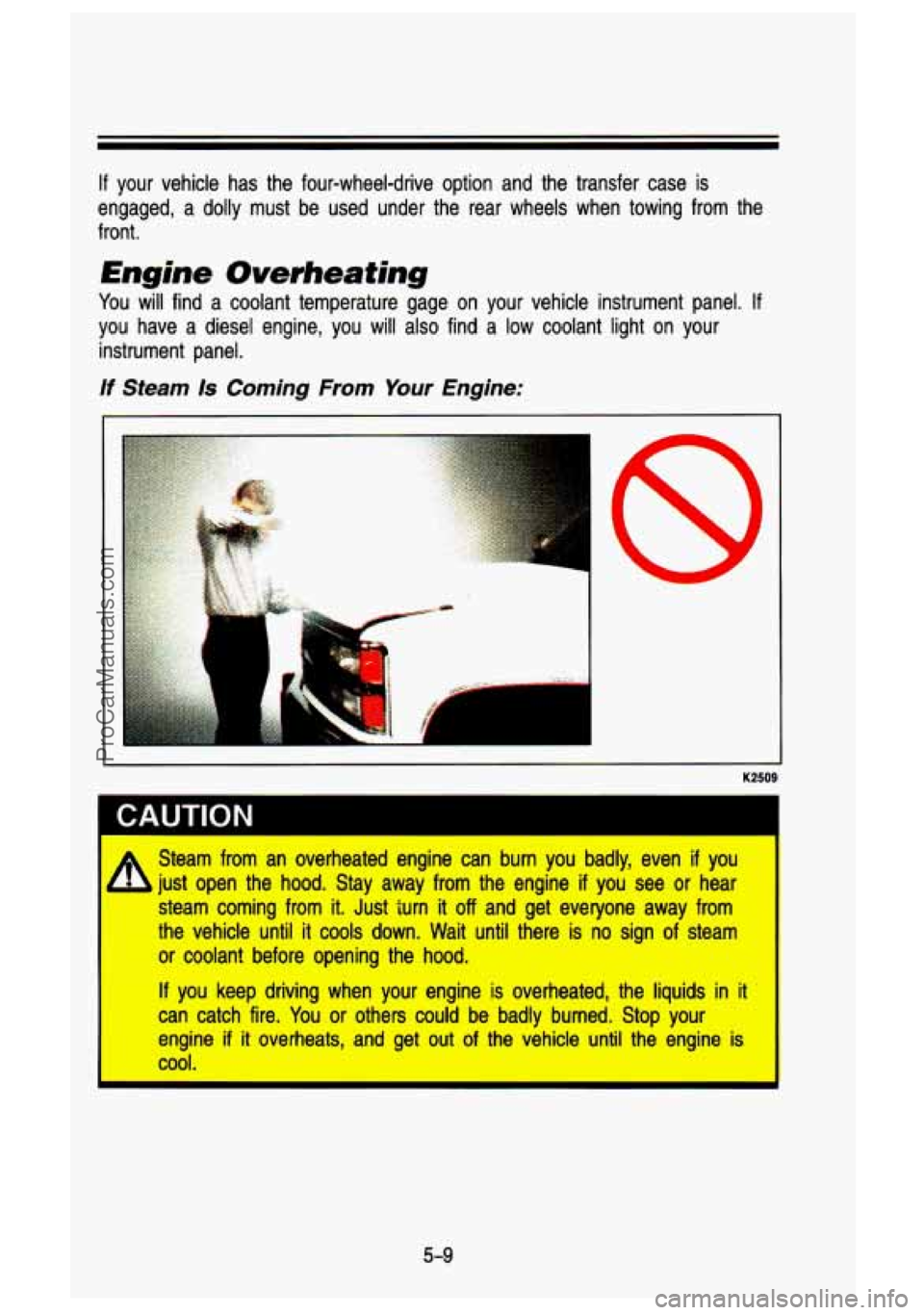
If your vehicle has the four-wheel-drive option and the transfer c\
ase is
engaged, a dolly must be used under the rear wheels when towi\
ng from the
front.
Engine Overheating
You will find a coolant temperature gage on your vehicle instrument\
panel. If
you have a diesel engine, you will also find a low coolant light on your
instrument panel.
If Steam Is Coming From Your Engine:
K2509
I CAUTION
A
Steam from an overheated engine can burn you badly, even if you
just open the hood. Stay away from the engine
if you see or hear
steam coming from it. Just turn
it off and get everyone away from
the vehicle until
it cools down. Wait until there is no sign of steam
or coolant before opening the hood.
If you keep driving when your engine is overheated, the liquids in it
can catch fire. You or others could be badly burned. Stop your
engine
if it overheats, and get out of the vehicle until the engine is
cool.
5-9
ProCarManuals.com
Page 252 of 436
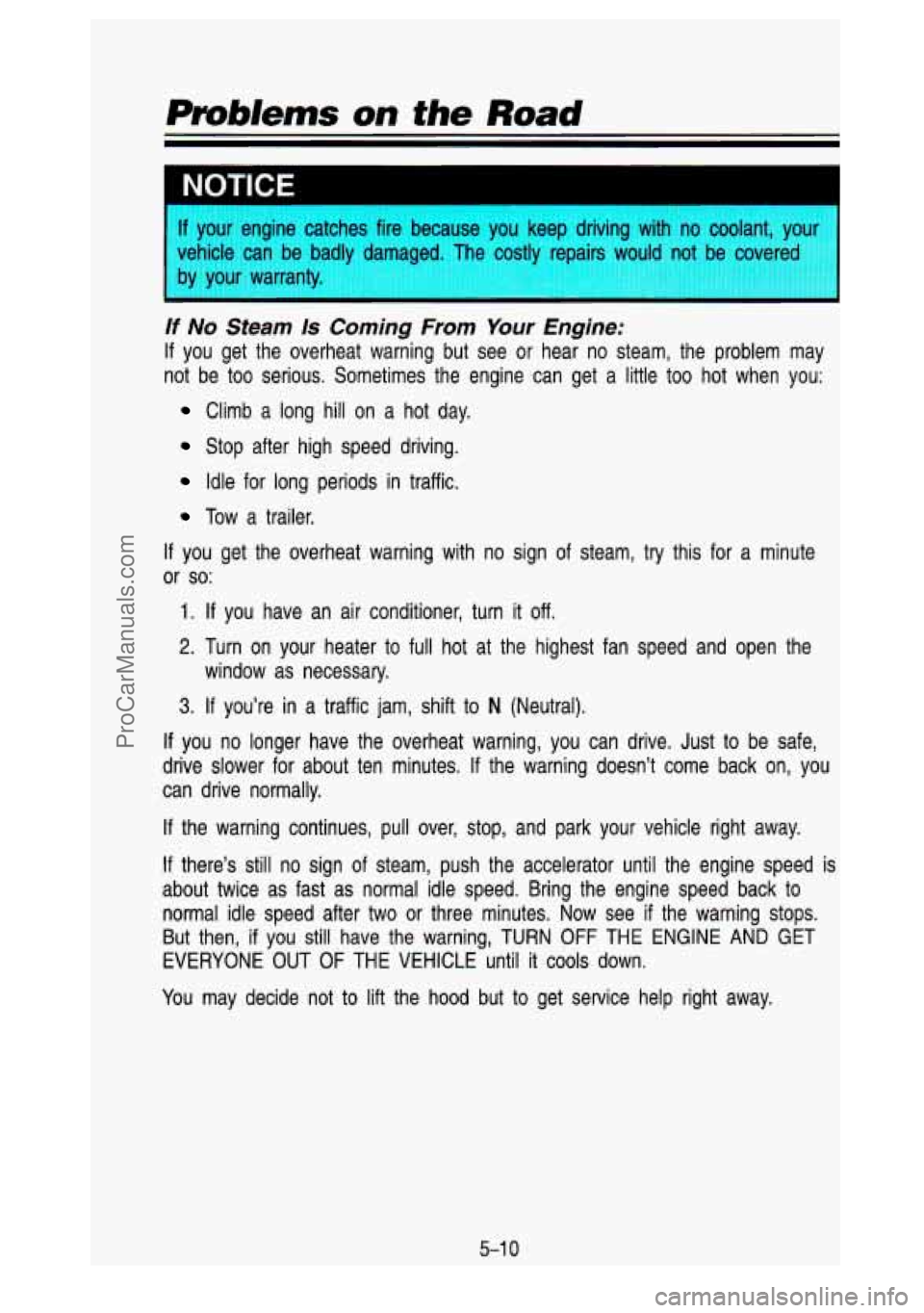
Problems on the Road
If your engine catches fire because you keep driving with no cool\
ant, your
vehicle can be bac"lI damaged.
T- ! costly rep; 1 would not be Iverec
by your warranty.
If No Steam Is Coming From Your Engine:
If you get the overheat warning but see or hear no steam, th\
e problem may
not be too serious. Sometimes the engine can get a little too\
hot when you:
Climb a long hill on a hot day.
Stop after high speed driving.
Idle for long periods in traffic.
Tow a trailer.
If you get the overheat warning with no sign of steam, try t\
his for a minute
or
so:
1. If you have an air conditioner, turn it off.
2. Turn on your heater to full hot at the highest fan speed and\
open the
3. If you're in a traffic jam, shift to N (Neutral).
window as necessary.
If you no longer have the overheat warning, you can drive. Just
to be safe,
drive slower for about ten minutes.
If the warning doesn't come back on, you
can drive normally.
If the warning continues, pull over, stop, and park your vehic\
le right away.
If there's still no sign of steam, push the accelerator until the engine speed is
about twice
as fast as normal idle speed. Bring the engine speed back to
normal idle speed after two or three minutes. Now see if the warning stops.
But then,
if you still have the warning, TURN OFF THE ENGINE AND GET
EVERYONE
OUT OF THE VEHICLE until it cools down.
You may decide not to
lift the hood but to get service help right away.
5-1 0
ProCarManuals.com
Page 253 of 436
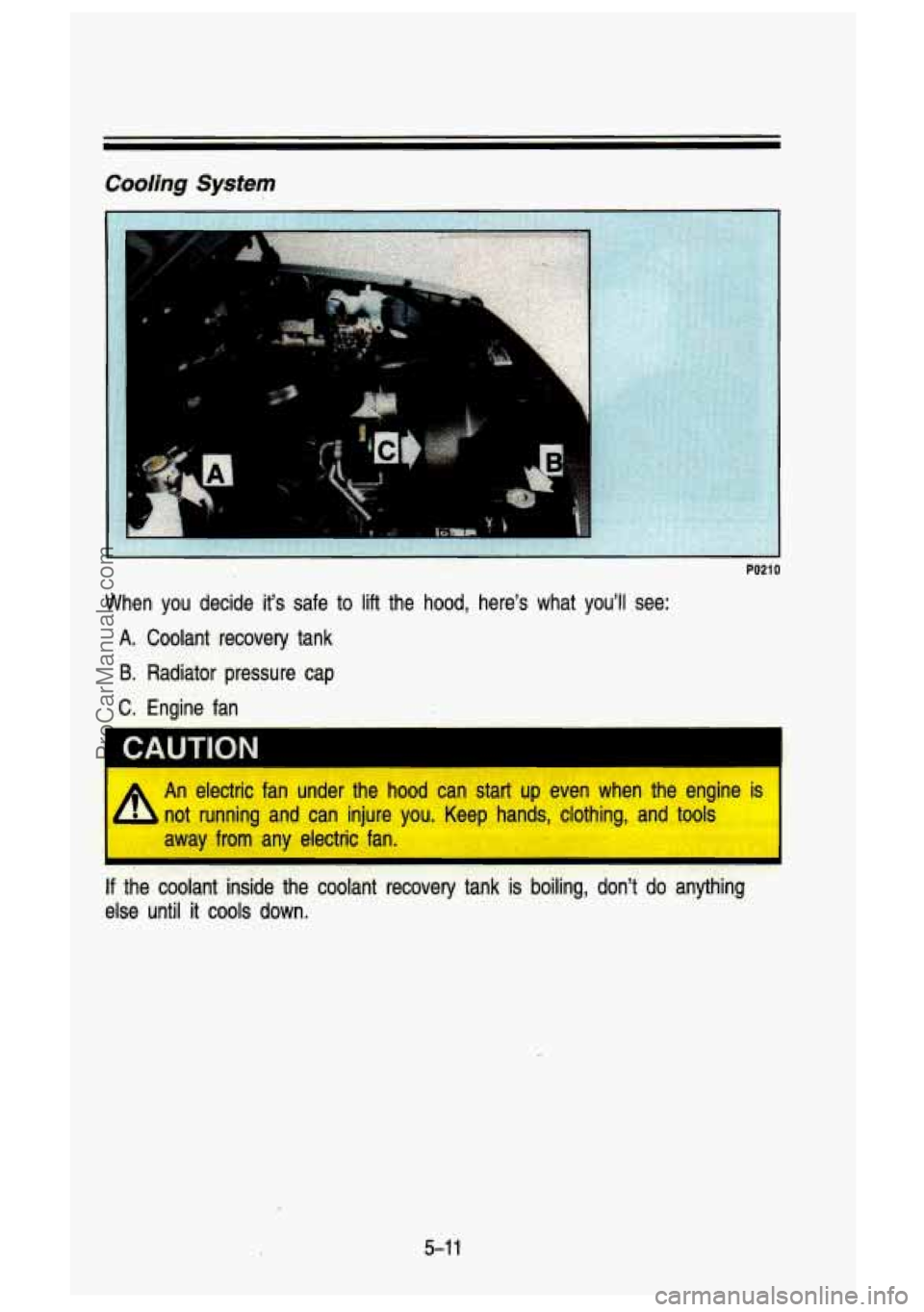
Cooling System
PO21 0
When you decide it’s safe to lift the hood, here’s what you’ll see:
A. Coolant recovery tank
B. Radiator pressure cap
C. Engine fan
CAUTION
‘4
An electric fan under the hood can start up even when the engine\
is
not running and can injure you. Keep hands, clothing, and tool\
s
away from any electric fan.
m
If the coolant inside the coolant recovery tank is boiling, don’t do anything
else until it cools down.
5-1 1
ProCarManuals.com
Page 254 of 436
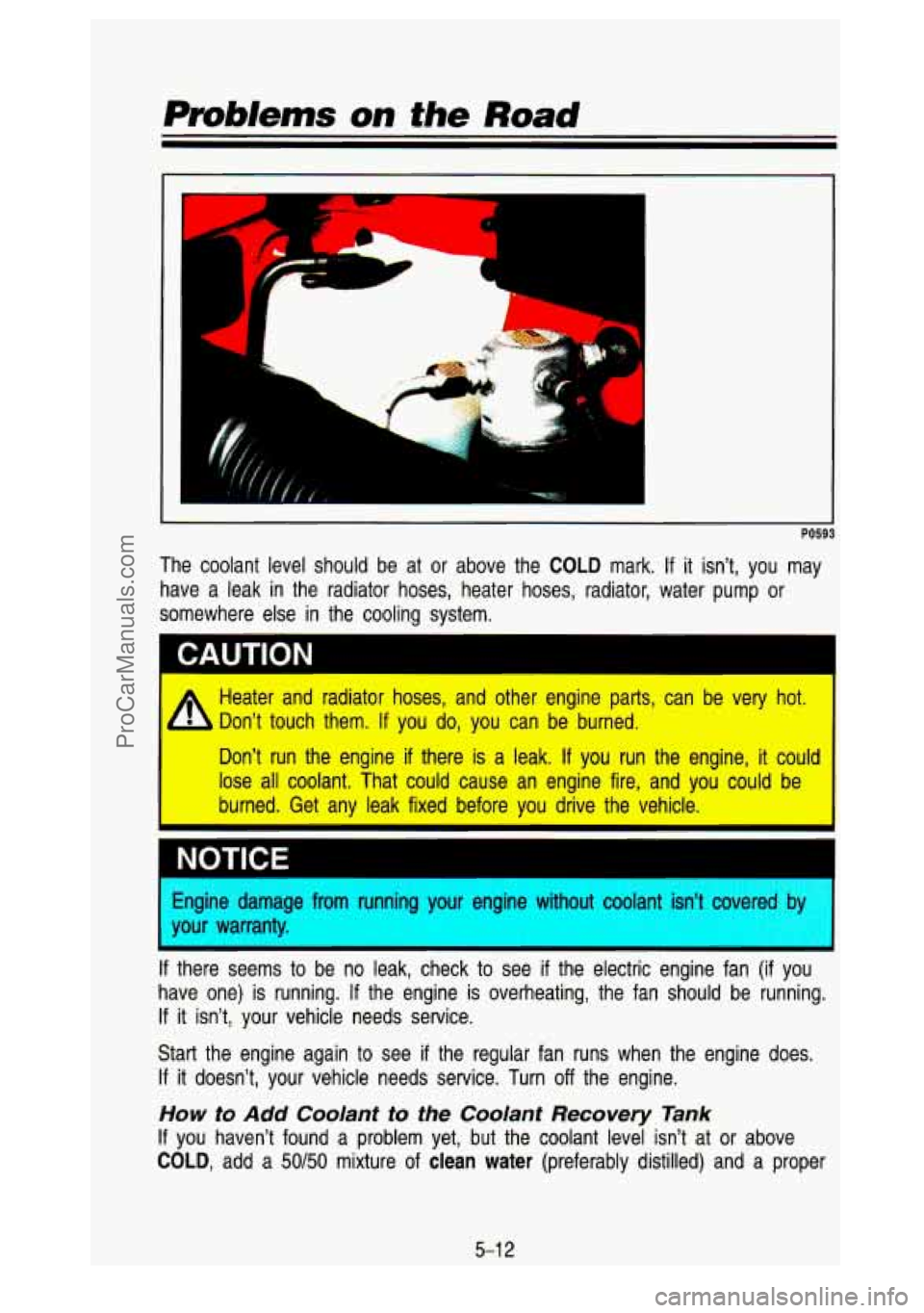
I
I
‘4
!b P4
LL
1
PO593
The coolant level should be at or above the COLD mark. If it isn’t, you may
have a leak in the radiator hoses, heater hoses, radiator, water pump or
somewhere else in the cooling system.
Heater and radiator hoses, and other engine parts, can be very\
hot.
-, Don’t touch them. If you do, you can be burned.
Don’t run the engine
if there is a leak. If you run the engine, it cou
lose all coolant. That could cause an engine fire, and you could be
burned. Get any leak fixed before you drive the vehicle.
I I
NOTICE
Engine damage from running your engine without coolant isn’t covered by
I your warranty.
If there seems to be no leak, check to see if the electric engine fan (if you
have one) is running.
If the engine is overheating, the fan should be running.
If it isn’t, your vehicle needs service.
Start the engine again to see
if the regular fan runs when the engine does.
If it doesn’t, your vehicle needs service. Turn off the engine.
How to Add Coolant to the Coolant Recovery Tank
If you haven’t found a problem yet, but the coolant level isn’t at or above
COLD, add a 50hO mixture of clean water (preferably distilled) and a proper
5-1 2
ProCarManuals.com
Page 255 of 436
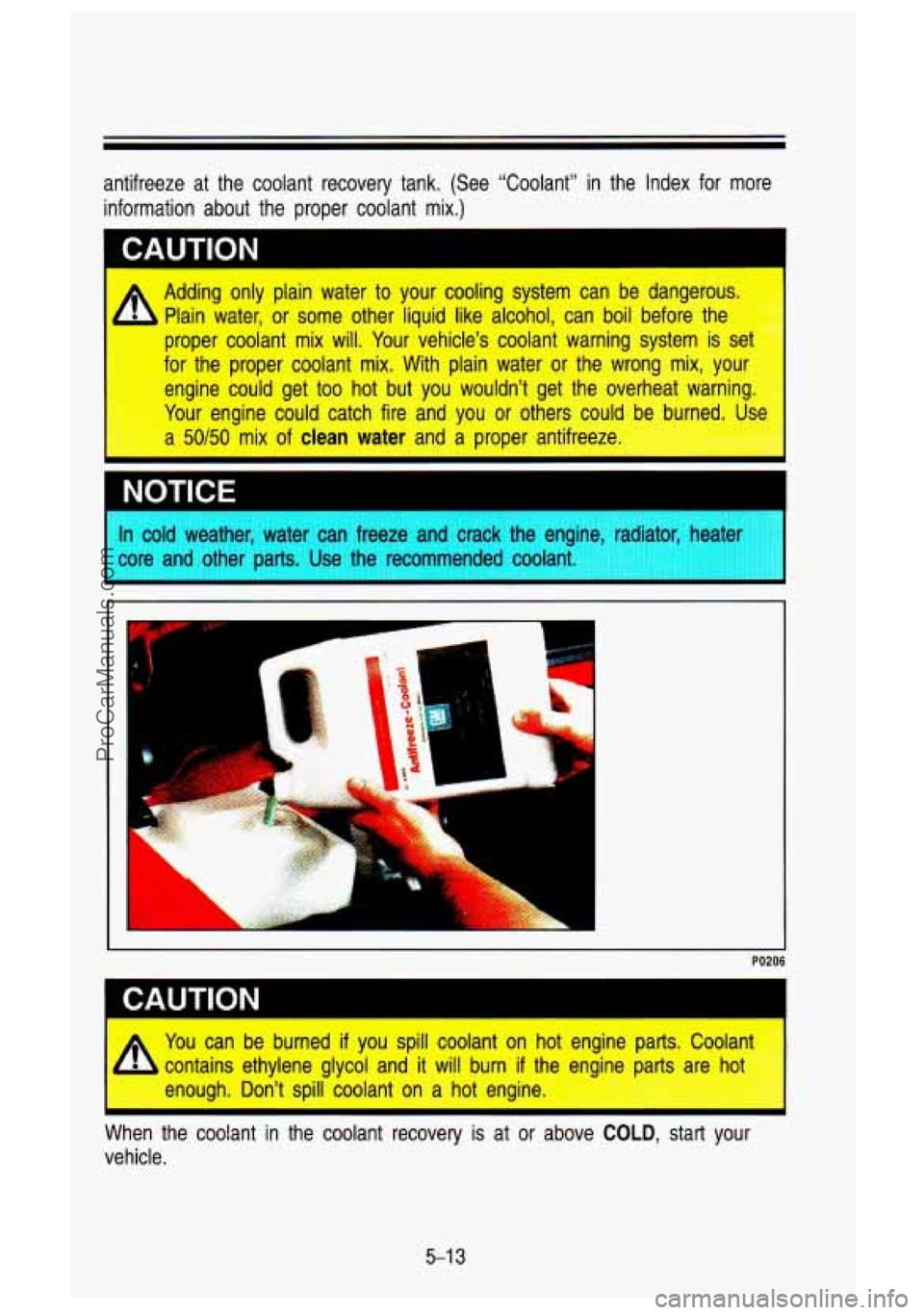
antifreeze at the coolant recovery tank. (See “Coolant” in the Index for more
information about the proper coolant mix.)
* Adding only plain water to your cooling system can be dangerous.
Plain water, or some other liquid like alcohol, can boil before the
proper coolant mix will. Your vehicle’s coolant warning system is
for the proper coolant mix. With plain water or the wrong mix, your
engine could get too hot but you wouldn’t get the overheat warning,
Your engine could catch fire and you or others could be burned.
USE
7 50/50 mix of clean water and a proper antifreeze.
I ln cold weather, water can freeze and crack the engine, radiator, heate\
r
:ore and other parts. Use the recommended coolant.
PO206
I * You can be burned if you spill coolant on hot engine parts. CoolQni
A contains ethylene glycol and it will burn if the engine parts are hut
enough. Don’t spill coolant on a hot engine.
When the coolant in the coolant recovery is at
or above COLD, start your
vehicle.
5-1 3
ProCarManuals.com
Page 256 of 436
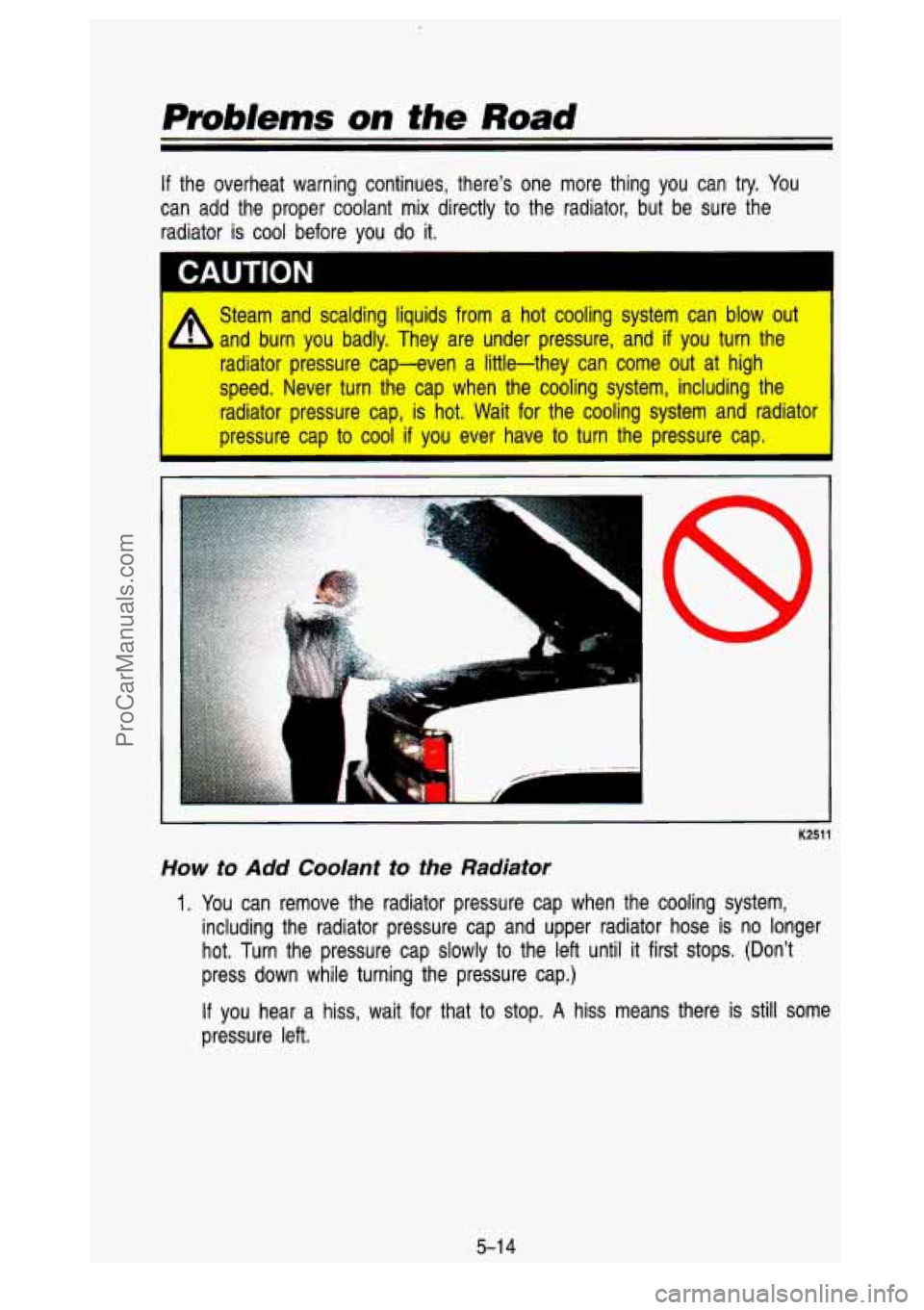
If the overheat warning continues, there’s one more thing you c\
an try. You
can add the proper coolant mix directly to the radiator, but \
be sure the radiator is cool before you
do it.
‘ Steam and scalding liquids from a hot cooling system can blow \
out
I- and burn you badly. They are under pressure, and if you turn the
radiator pressure cap-even a little-they can come out at high
speed. Never turn the cap when the cooling system, including t\
he radiator pressure cap, is hot. Wait for the cooling system and\
radiator
pressure cap to cool
if you ever have to turn the pressure cap. I
. . . .
1
K2Jll
How to Add Coolant to the Radiator
1. You can remove the radiator pressure cap when the cooling system,
including the radiator pressure cap and upper radiator hose is \
no longer
hot. Turn the pressure cap slowly to the
left until it first stops. (Don’t
press down while turning the pressure cap.)
If you hear a hiss, wait for that to stop. A hiss means there is still some
pressure left.
5-1 4
ProCarManuals.com
Page 257 of 436
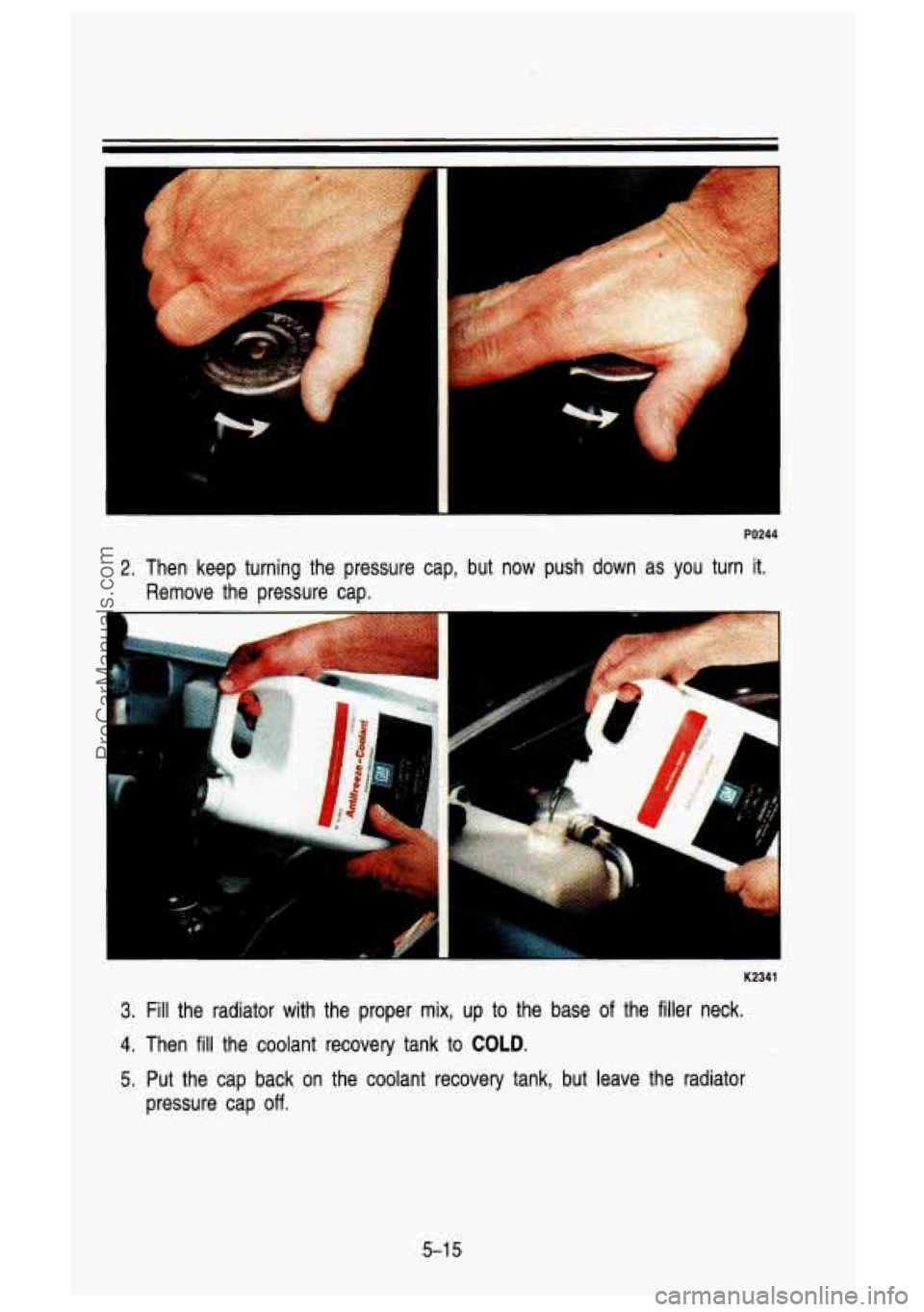
1
PO244
2. Then keep turning the pressure cap, but now push down as you turn it.
Remove the pressure cap.
K2341
3. Fill the radiator with the proper mix, up to the base of the filler neck.
4. Then fill the coolant recovery tank to COLD.
5. Put the cap back on the coolant recovery tank, but leave the \
radiator
pressure cap
off.
5-1 5
ProCarManuals.com
Page 258 of 436
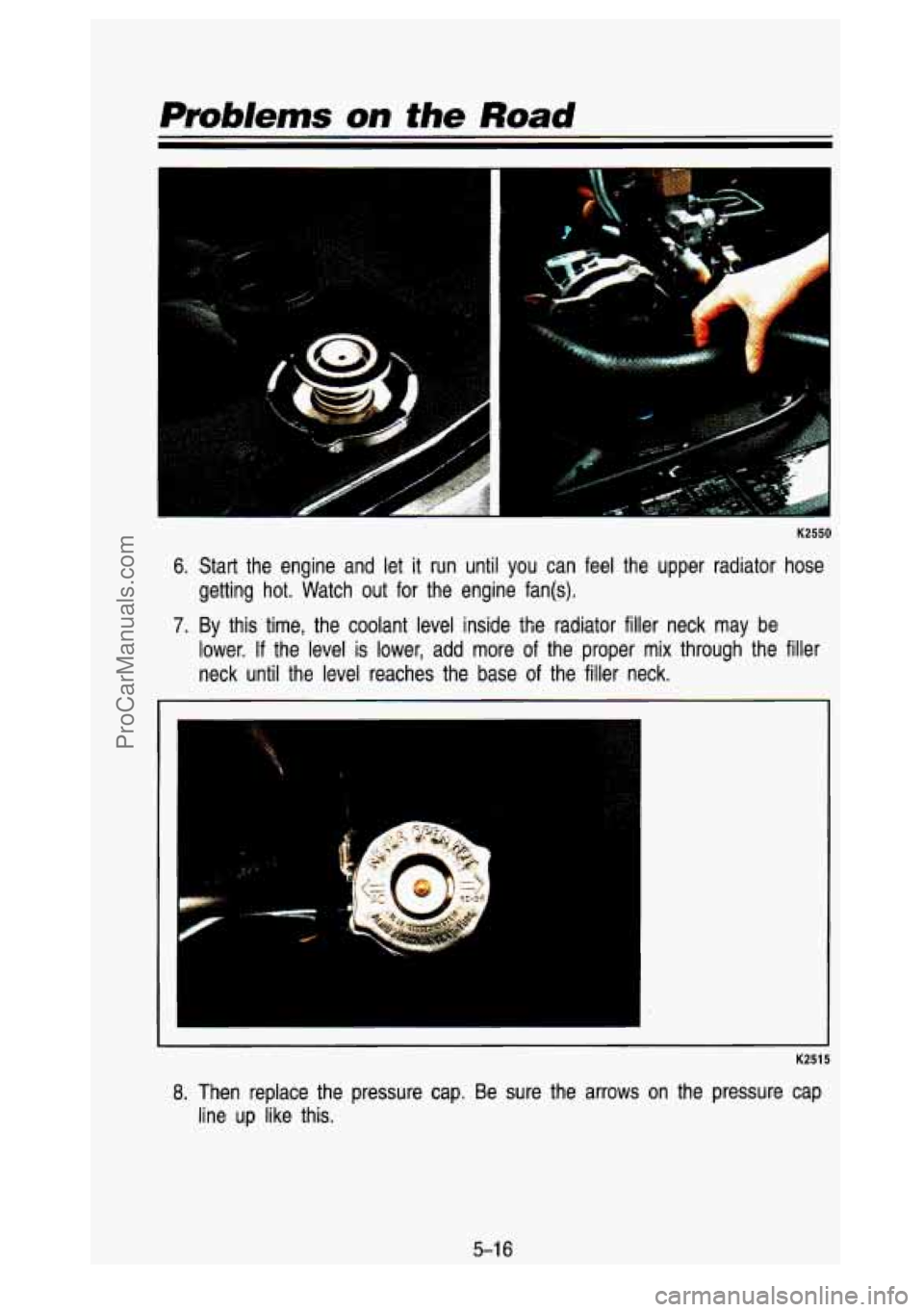
Prob/ems on the Road
t
e;
K2550
6. Start the engine and let it run until you can feel the upper radiator hose
getting hot. Watch out for the engine fan(s).
7. By this time, the coolant level inside the radiator filler neck m\
ay be
lower.
If the level is lower, add more of the proper mix through the f\
iller
neck until the level reaches the base of the filler neck.
K2515
8. Then replace the pressure cap. Be sure the arrows on the pressure cap
line up like this.
5-1 6
ProCarManuals.com
Page 259 of 436
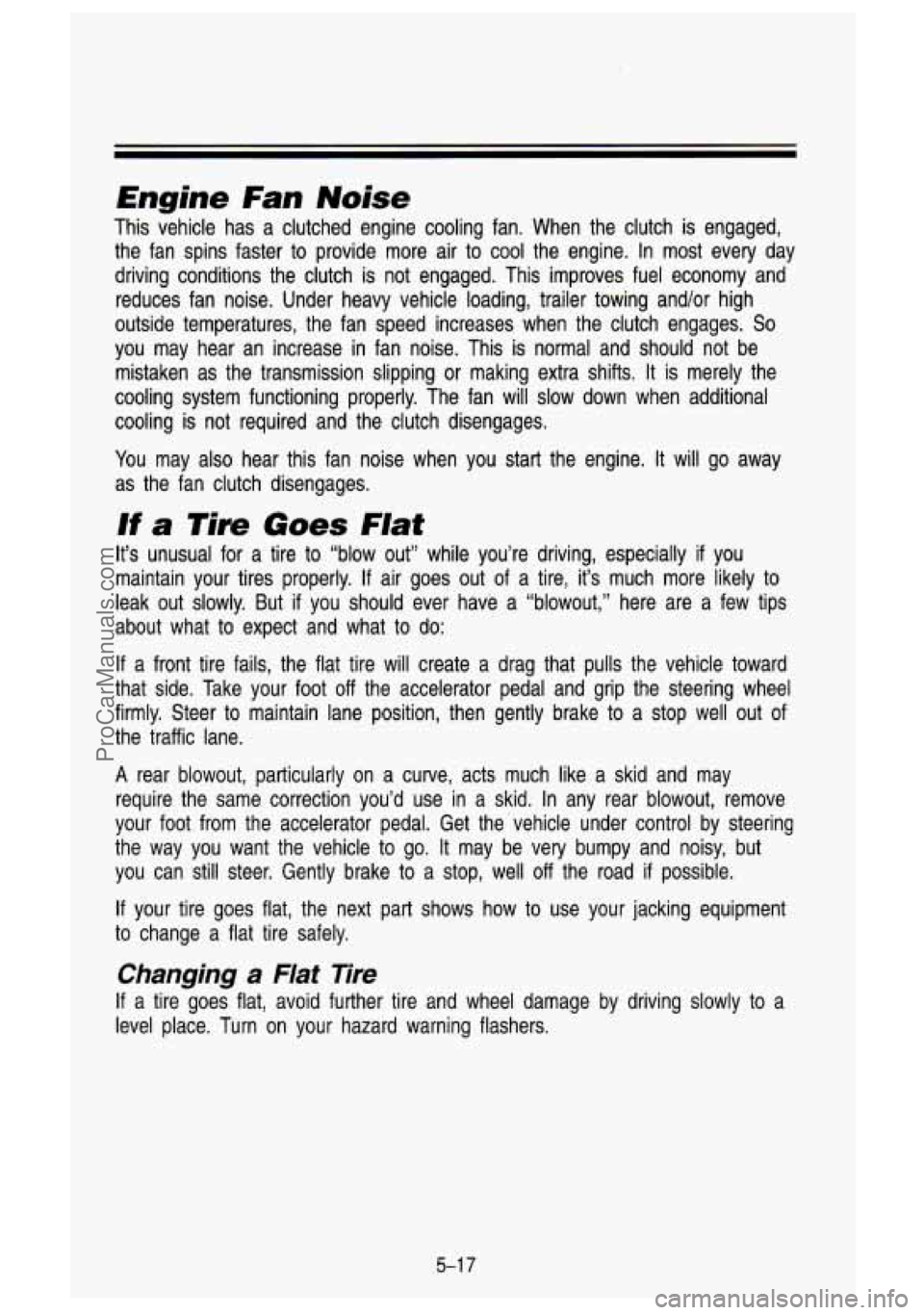
Engine Fan Noise
This vehicle has a clutched engine cooling fan. When the clutch is engaged,
the fan spins faster to provide more air to
cool the engine. In most every day
driving conditions the clutch is not engaged. This improves fue\
l economy and
reduces fan noise. Under heavy vehicle loading, trailer towing andlor high
outside temperatures, the fan speed increases when the clutch e\
ngages.
So
you may hear an increase in fan noise. This is normal and should not be
mistaken as the transmission slipping or making extra shifts. It is merely the
cooling system functioning properly. The fan will
slow down when additional
cooling is not required and the clutch disengages.
You may also hear this fan noise when you start the engine. It will go away
as the fan clutch disengages.
If a Tire Goes Fiat
It’s unusual for a tire to “blow out” while you’re driving, especially if you
maintain your tires properly. If air goes out of a tire, it’s much more likely to
leak out slowly. But
if you should ever have a “blowout,” here are a few tips
about what to expect and what to do:
If a front tire fails, the flat tire will create a drag that pulls the vehicle toward
that side. Take your foot off the accelerator pedal and grip \
the steering wheel
firmly. Steer to maintain lane position, then gently brake to a stop well out of
the traffic lane.
A rear blowout, particularly on a curve, acts much like a skid and may
require the same correction you’d use in a skid. In any rear blowout, remove
your foot from the accelerator pedal. Get the‘vehicle under control by steering
the way you want the vehicle to go. It may be very bumpy and noisy, but
you can still steer. Gently brake to a stop, well off the road
if possible.
If your tire goes flat, the next part shows how to use your jacking equipment
to change a flat tire safely.
Changing a Flat Tire
If a tire goes flat, avoid further tire and wheel damage by driv\
ing slowly to a
level place. Turn on your hazard warning flashers.
5-1 7
ProCarManuals.com
Page 260 of 436
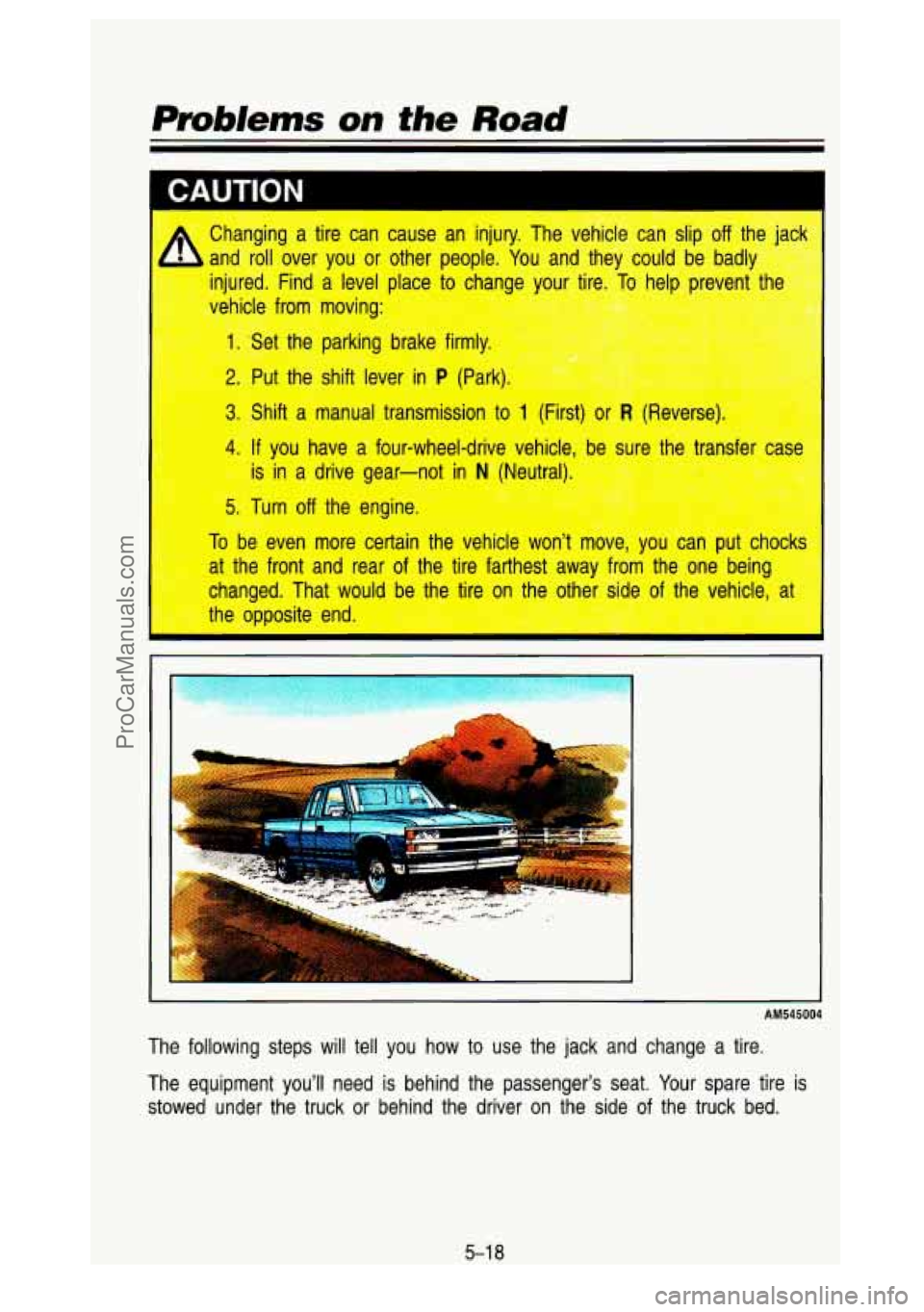
Pmb/ems on the Road
vnu I IVII
A Changing a tire can cause an injury. The vehicle can slip off the iac
and roll over you or other people. You and they could be badly
injured. Find
a level dace .. , to ,dbanr voy&&g. To heh Drevent tt-
fehicle from m
E -,>1-
-ut the shift lever in P (P
hift a manual transmission to 1 (First) ur r never 3.
To be even more certain the vehicle won’t move, you can put c\
hocks
at the front and rear of the tire farthest away from the one being
changed. That would be the tire on the other side of the vehicle, at
the opposite end.
.
AM545004
The following steps will tell you how to use the jack and ch\
ange a tire.
The equipment you’ll need is behind the passenger’s seat. \
Your spare tire is
stowed under the truck or behind the driver on the side of the truck bed.
5-1 8
ProCarManuals.com